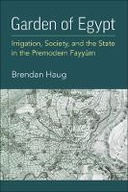Explore

Garden of Egypt: Irrigation, Society, and the State in the Premodern Fayyūm is the first environmental history of Egypt’s Fayyūm depression. The volume studies human relationships with flowing water, from the third century BCE to the thirteenth century CE. Until the arrival of modern perennial irrigation in the nineteenth century, the Fayyūm was the only region of premodern Egypt to be irrigated by a network of artificial canals. By linking large numbers of rural communities together in shared dependence on this public irrigation infrastructure, canalization introduced to Egypt a radically new way of interacting both with the water of the Nile and with fellow farmers. Drawing upon ancient Greek papyri, medieval Arabic literature, and modern comparative evidence, this book explores the ways in which the Nile’s water, local farmers, and state power together continually reshaped this irrigated landscape over more than thirteen centuries. Following human/water relationships through both space and time further helps to erode disciplinary boundaries and bring multiple periods of Egyptian history into contact with one another.
This book is included in DOAB.
Why read this book? Have your say.
You must be logged in to comment.
Rights Information
Are you the author or publisher of this work? If so, you can claim it as yours by registering as an Unglue.it rights holder.Downloads
This work has been downloaded 11 times via unglue.it ebook links.
- 11 - pdf (CC BY-NC) at OAPEN Library.
Keywords
- thema EDItEUR::J Society and Social Sciences::JB Society and culture: general
- thema EDItEUR::N History and Archaeology::NH History
- thema EDItEUR::N History and Archaeology::NH History::NHC Ancient history
- thema EDItEUR::N History and Archaeology::NH History::NHD European history::NHDA European history: the Romans
- thema EDItEUR::N History and Archaeology::NK Archaeology
Links
DOI: 10.3998/mpub.11736090Editions

